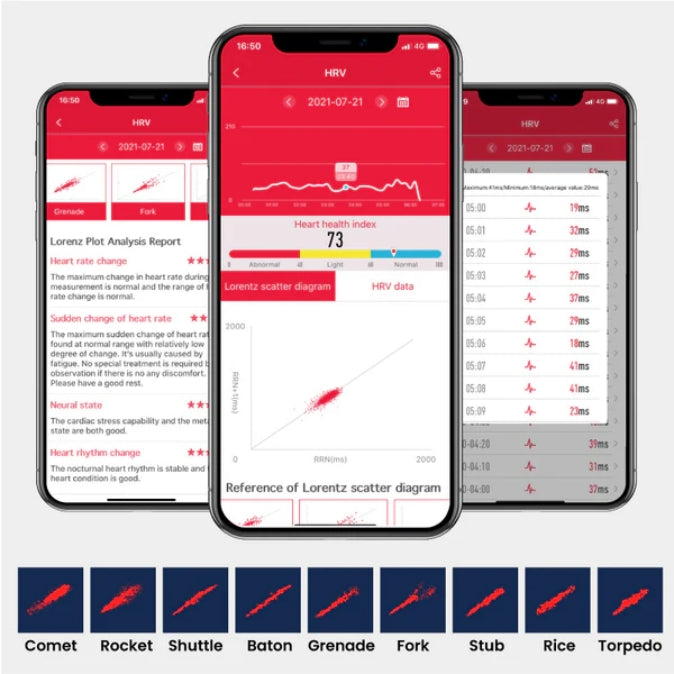In today's fast-paced world, keeping tabs on your health and well-being has never been more crucial. One vital metric that has gained significant attention in recent years is Heart Rate Variability (HRV). HRV is a powerful indicator of your overall health, and a HRV smartwatch is a convenient tool for tracking it. In this article, we will delve into the nine key aspects of HRV and why owning a HRV smartwatch is essential.
What Is HRV (Heart Rate Variability)?
Heart Rate Variability is the variation in time between successive heartbeats. It measures the subtle changes in the intervals between heartbeats, providing insights into your autonomic nervous system's activity. In simple terms, HRV reflects the balance between the sympathetic (fight-or-flight) and parasympathetic (rest-and-digest) nervous systems.
Which Lifestyle Factors Impact HRV?
Numerous lifestyle factors can influence your HRV. Stress, lack of sleep, poor diet, excessive alcohol consumption, and physical inactivity can all lead to reduced HRV. Conversely, practices like regular exercise, meditation, and adequate sleep can enhance HRV.
How to Check Your Heart Rate Variability?
HRV can be measured using a heart rate monitor. While traditional heart rate monitors give you your heart rate, HRV requires more advanced technology. This is where HRV smartwatches come into play.
Why Check Heart Rate Variability?
Monitoring HRV provides valuable insights into your overall well-being. It can help detect early signs of overtraining, stress, or illness, allowing you to take preventive measures before more severe issues arise.
What Is a Normal Heart Rate Variability?
Normal HRV values can vary among individuals, but a higher HRV generally signifies better health.
The HRV numerical range can vary depending on the specific analysis method used and the device or software interpreting the data. Here are some general guidelines:
- High-Frequency (HF) HRV: This is a common HRV measurement, representing the variation in heart rate due to the respiratory cycle and parasympathetic nervous system activity. HF-HRV values typically range from around 20 to 200 ms^2 (milliseconds squared).
- Low-Frequency (LF) HRV: LF-HRV represents the combined activity of both the sympathetic and parasympathetic nervous systems. LF-HRV values typically range from about 20 to 200 ms^2.
- Root Mean Square of Successive Differences (RMSSD): RMSSD is another widely used HRV metric, which represents short-term HRV. It is typically measured in milliseconds and can range from around 10 to 100 ms.
- Standard Deviation of NN (Normal-to-Normal) Intervals (SDNN): SDNN is a measure of overall HRV, including both short-term and long-term variability. It is also measured in milliseconds and can range from 20 to 200 ms or more.
- Total Power (TP): TP represents the total HRV within the entire frequency range. It encompasses both LF and HF components, and its values can range from approximately 1,000 to 10,000 ms^2 or more.
- SDNN Index (SDNNi): SDNNi is often used for 24-hour HRV monitoring. It is typically reported in ms and can range from around 50 to 150 ms or more.
It's important to note that these numerical ranges are approximate and can vary depending on factors such as age, fitness level, and individual variability. Additionally, different HRV analysis tools and software may use slightly different ranges or units. It's essential to establish your baseline HRV, as changes from this baseline can indicate stress, illness, or other health concerns.
How Does a Smartwatch Measure HRV?
HRV smartwatches use a combination of photoplethysmography (PPG) sensors and accelerometers to monitor your heart rate and body movements. These sensors capture data that is then processed to calculate HRV. Fitaos Vee ECG smartwatch uses an ECG (Electrocardiogram) sensor to monitor heart rate, which ensures that the measured HRV data will be more accurate. Our HRV app uses RMSSD HRV metric to monitor HRV, the milliseconds can range from around 10 to 100 ms. As can be seen from our H band app, a value between 0-40 is abnormal, 40-60 is the middle range, and 60-100 is the normal range.

Benefits of HRV Smartwatches
The advantages of owning a HRV smartwatch are numerous. They provide real-time monitoring, allowing you to make immediate lifestyle adjustments based on your HRV data. Additionally, many smartwatches sync with apps that offer detailed insights into your HRV trends over time. This information empowers you to optimize your health and well-being. Fitaos Vee smart watch and our health monitoring app introduces the Lorentz scatter diagram, which uses the monitored real-time HRV data to correspond to different waveform diagrams, thereby providing more professional and accurate HRV conclusions and suggestions.

You can improve your HRV based on the conclusions and suggestions given by the Lorentz plot analysis report. For example, you should reduce stress through mindfulness practices, get adequate sleep, maintain a healthy diet, and engage in regular physical activity.

Conclusion
In conclusion, a HRV smartwatch is a valuable tool for anyone looking to take control of their health. It provides insights into your autonomic nervous system activity, detects potential health issues early on, and encourages positive lifestyle changes. By investing in a HRV smartwatch, you can take a proactive approach to your well-being and lead a healthier, more balanced life.

